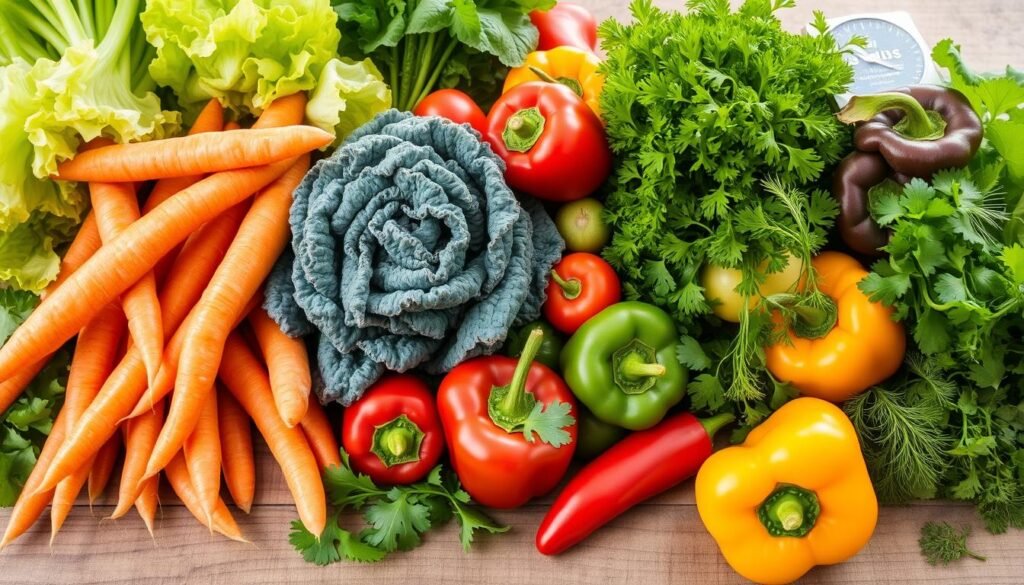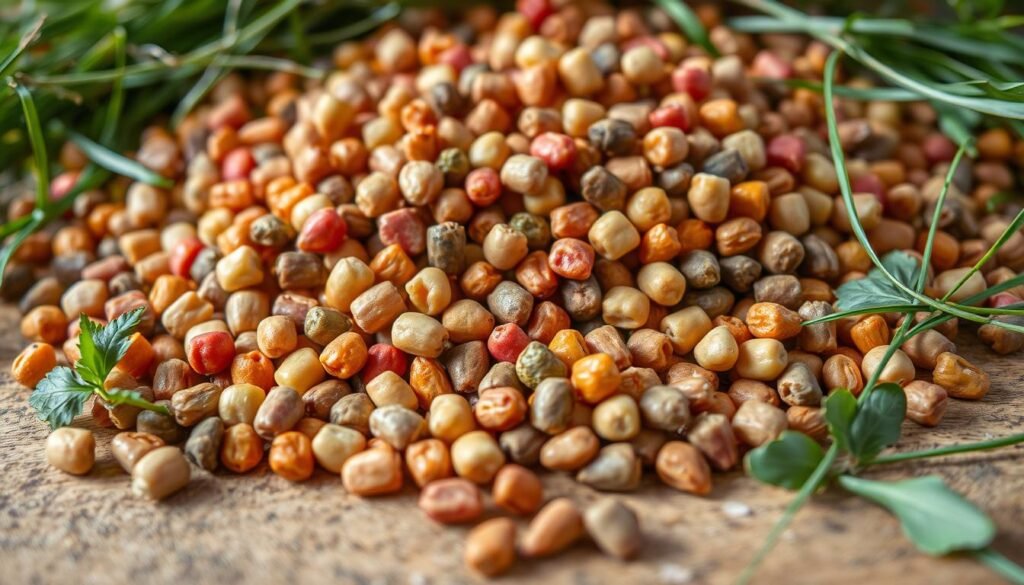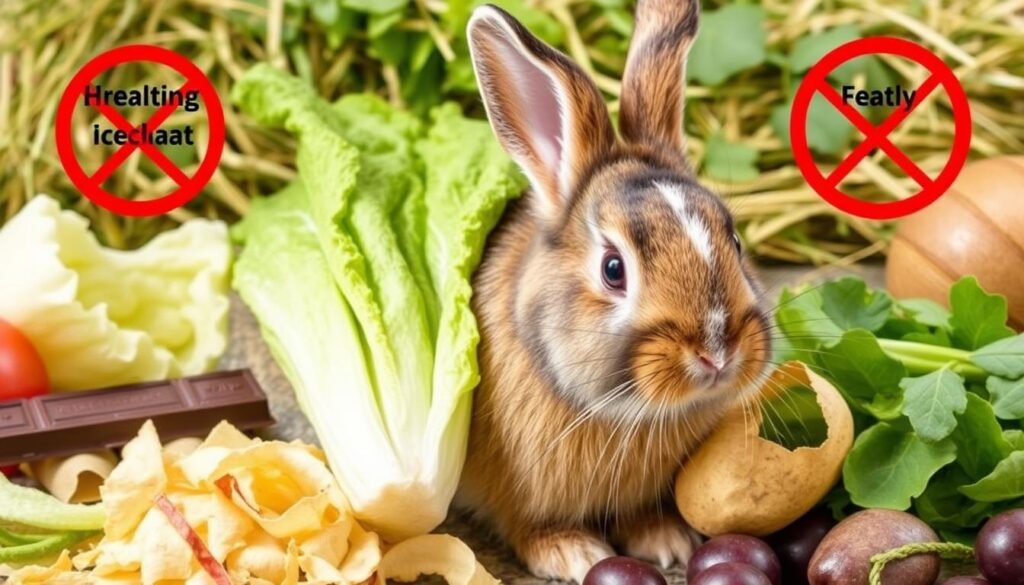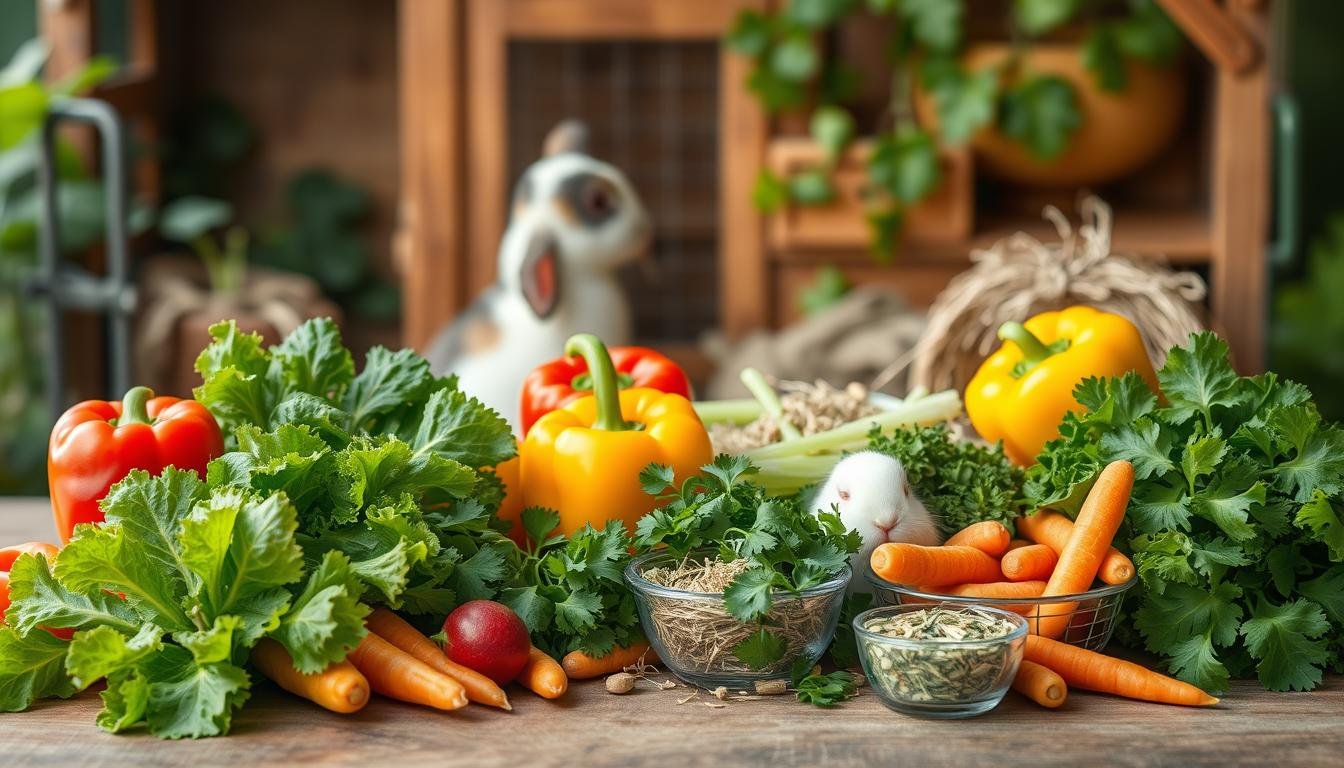As a rabbit owner, I’ve learned that about 80% of a rabbit’s diet should be hay or grass. This is key for their health and well-being1. Knowing what foods are safe for rabbits is crucial. Hay, vegetables, and fruits are important for their health.
Rabbit nutrition is complex, but it’s vital to feed them a balanced diet. This includes hay, vegetables, and fruits. It’s important to know what foods are safe for rabbits to eat. This ensures they get the nutrients they need.
Key Takeaways
- Approximately 80% of a rabbit’s diet should consist of hay or grass1.
- Rabbit-safe foods, including hay, vegetables, and fruits, are necessary for a healthy diet.
- High-quality rabbit pellets should be given in recommended serving sizes based on the rabbit’s weight1.
- Fresh vegetables, such as romaine lettuce, parsley, and kale, should be monitored to ensure they are fresh and not frozen1.
- Understanding rabbit nutrition is essential to providing a balanced diet and knowing what can rabbits eat.
- Rabbit nutrition is a complex topic, but providing a balanced diet that includes rabbit-safe foods is crucial for maintaining optimal health.
- Rabbit owners should be aware of the importance of rabbit nutrition and take steps to provide a healthy and balanced diet.
Understanding Your Rabbit’s Basic Nutritional Needs
As a rabbit owner, knowing what your pet needs is key to their health. Rabbits need a diet full of fiber and important nutrients like vitamins and minerals. Their needs change based on their age, size, and how active they are2.
Rabbits should eat lots of fresh grass hay and some high-quality pellets. They also need fresh, safe leafy greens3. Vegetables like romaine lettuce, parsley, and kale should be fresh, not frozen, to keep their stomachs happy2. Fruits like apples (without seeds), strawberries, and bananas are okay in small amounts because they’re sweet2.
Rabbits need a diet rich in fiber, which makes up about 80% of their food4. Hay is crucial for their gut health and to prevent digestive problems4. A balanced diet is essential for their health and happiness.
Knowing what your rabbit needs is important for their happiness and health. By giving them the right nutrients and meeting their daily needs, you can keep them healthy and strengthen your bond.
What Can Rabbits Eat: The Complete Food List
As a rabbit owner, it’s key to give your pet a balanced diet. This diet should include hay, vegetables, fruits, and pellets. According to5, rabbits need fresh timothy hay all the time. This hay helps their digestive health and gut bacteria.
A good diet for rabbits should have high fiber veggies like collard greens and kale. These veggies are good for their diet5. But, it’s important to not give too much water-rich veggies like Romaine lettuce. This can cause diarrhea5. Here’s a list of rabbit-safe foods:
| Food Type | Examples |
|---|---|
| Hay | Timothy hay, orchard hay |
| Vegetables | Collard greens, kale, carrots |
| Fruits | Apples, bananas, berries |
| Pellets | High-quality rabbit pellets |
Adult rabbits should eat about 85% of their diet in hay6. It’s also crucial to start giving hay to young bunnies as soon as they can eat on their own6. By giving a balanced diet with different rabbit-safe foods, your pet will stay healthy and happy.
Hay: The Foundation of Your Rabbit’s Diet
As a rabbit owner, knowing the role of hay in your pet’s diet is key. Hay is the main source of fiber for rabbits, keeping their digestive system healthy7. There are different types of hay, like timothy hay and alfalfa hay, each offering unique nutritional benefits.
Keeping hay fresh and dry is vital to prevent mold and bacteria. Proper storage helps keep the hay’s quality and nutritional value8. Here are some tips for storing hay:
- Store hay in a cool, dry place
- Keep hay away from direct sunlight
- Use airtight containers to prevent moisture
By offering your rabbit a variety of hay and using the right storage methods, you can ensure a balanced diet7. Always choose high-quality hay that is fresh and free of mold and bacteria8.
| Type of Hay | Nutritional Benefits |
|---|---|
| Timothy Hay | High in fiber, low in protein |
| Alfalfa Hay | High in protein, rich in calcium |
Fresh Vegetables for Your Rabbit
As a rabbit owner, it’s key to give your pet a mix of fresh vegetables. This ensures they get the nutrients they need for good health9. Rabbits need a lot of fiber, and vegetables for rabbits are a great source. Leafy greens like kale and spinach, and crunchy snacks like carrots and bell peppers, are good choices.
Start new fresh vegetables slowly to avoid upset stomachs9. Offer a variety of vegetables every day. Make sure to include different colors to get a range of nutrients. Some rabbit-safe vegetables can be eaten daily, while others should be limited to a few times a week10.

Always pick fresh vegetables that are pesticide-free and heavy metal-free. Wash them well before giving them to your rabbit10. By giving your rabbit a variety of vegetables for rabbits, you help them live a happy and healthy life.
Safe Fruits as Occasional Treats
As a rabbit owner, it’s key to know that fruits for rabbits can add variety to their diet. But, they should be given in small amounts. Safe fruits like apples, bananas, and berries are good as fruit treats. Just remember, they should not make up more than 2% of a rabbit’s daily food11.
Introducing fruits for rabbits as fruit treats should be done slowly and in small amounts. This helps avoid digestive problems11. Some safe fruits include apples, bananas, and berries. But, make sure to remove any seeds or pits to avoid toxicity11. Start with a small slice of apple or a few berries as a fruit treat and watch your rabbit’s reaction before giving more.
It’s also important to give fruits for rabbits at the right time. For example, giving fruit treats in the morning can give them energy for the day12. Also, make sure your rabbit always has fresh water to prevent dehydration12.
In conclusion, safe fruits can add variety to a rabbit’s diet, but they should be given in moderation as fruit treats. By following these guidelines and introducing fruits for rabbits slowly, you can keep your rabbit happy and healthy.
Commercial Rabbit Pellets: Guidelines and Recommendations
Feeding your rabbit commercial pellets can be a good choice. But, it’s key to pick high-quality pellets that fit your rabbit’s needs. The guidelines say a rabbit’s diet should be mostly hay or grass, with pellets being a smaller part13. Here’s how much pellets your rabbit might need each day, based on their weight:
- 2 lbs: 2 tbsp
- 3 lbs: 3 tbsp
- 4 lbs: ¼ cup
- 5 lbs: 1 tbsp + ¼ cup
- 6 lbs: 2 tbsp + ¼ cup
It’s important to stick to these guidelines to make sure your rabbit gets the right nutrients. Choose pellets based on your rabbit’s age, weight, and needs. For example, young rabbits under 7 months should eat unlimited alfalfa hay and pellets. Adults should get 1/4 to 1/2 cup of pellets for every 6 lbs of body weight13. By following these guidelines and picking quality pellets, you can keep your rabbit healthy and happy.

Always introduce new foods, like pellets, slowly to avoid upset stomachs. Make sure to give your rabbit fresh water at least twice a day. Also, limit treats to no more than 10% of their daily calories14. By following these tips, you can help your rabbit get the nutrients they need to thrive.
Foods That Are Toxic to Rabbits
As a responsible rabbit owner, knowing which foods are toxic is key. Toxic foods for rabbits can lead to serious health problems, like stomach issues and even death. A rabbit’s diet should be mostly hay (80%), with veggies (10%), pellets (5%), and treats (5%)15. But, some fruits, like cherries, can harm rabbits if given too much16.
Here’s a list of toxic plants to avoid:
- Onions and garlic
- Mushrooms
- Raw or undercooked beans
- Avocado
- Cherry pits
Make sure to keep thesetoxic foods for rabbits away from them. Cabbage is good for rabbits, but add it slowly to avoid stomach problems17.
Knowing about rabbit poison in foods and plants helps keep your rabbit safe. Always introduce new foods slowly and in small amounts to avoid bad reactions. For more info on safe and toxic foods for rabbits, talk to a vet or a trusted source1516, and17.
Creating a Balanced Feeding Schedule
To keep your rabbit healthy, you need a balanced feeding schedule. This schedule should fit your rabbit’s age, size, and how active they are18. A good diet is key for your rabbit’s health and happiness.
In the morning, give your rabbit fresh hay like Timothy Hay and a bit of high-quality pellets19. Add fresh veggies like leafy greens, but do it slowly to avoid stomach problems18. For dinner, offer a mix of hay, pellets, and veggies. Make sure they always have fresh water.
Planning meals for the week is important too. It helps make sure your rabbit gets the right food every day18. Here’s a simple meal plan:
- Monday: Hay and pellets, with fresh veggies like kale and carrots
- Tuesday: Hay and pellets, with fresh fruit like apples and bananas
- Wednesday: Hay and pellets, with leafy greens like spinach and lettuce
By sticking to a balanced diet and meal planning, your rabbit will stay healthy and happy19. Always give them fresh water and a clean home to keep them well.
| Food Type | Recommended Amount |
|---|---|
| Hay | Unlimited |
| Pellets | Limited (based on weight and activity level) |
| Vegetables | Variety, introduced gradually |
Signs of a Healthy Diet in Rabbits
A healthy diet is key for your rabbit’s health. Hay is vital for their digestive health20. Rabbits need 70-75% hay to stay healthy20. Look for a shiny coat, bright eyes, and regular bowel movements to know they’re eating right.
Watch out for health problems like gastrointestinal stasis, which can be deadly21. A diet rich in fiber keeps their gut moving well21. Feed them fresh veggies and fruits, along with quality hay6.
Signs of a healthy rabbit diet include:
- Shiny coat
- Bright eyes
- Regular bowel movements
- Good appetite
- Healthy weight
Keeping your rabbit’s diet healthy is crucial for their well-being20. By watching their diet and health, you can prevent problems and ensure a long, happy life20.
| Signs of Health | Description |
|---|---|
| Shiny Coat | A healthy rabbit’s coat should be shiny and well-groomed |
| Bright Eyes | Healthy rabbits should have bright, alert eyes |
| Regular Bowel Movements | Rabbits should have regular bowel movements, with droppings that are well-formed and brown in color |
By following these guidelines and monitoring your rabbit’s health, you can help ensure your pet is getting a healthy rabbit diet and living a happy and healthy life6.
Common Feeding Mistakes to Avoid
As a rabbit owner, knowing common feeding mistakes is key. Overfeeding can cause obesity and health problems22. Also, introducing food incorrectly can upset your rabbit’s stomach23.
It’s vital to give your rabbit a balanced diet. They need lots of hay and only a little bit of fruits and veggies22. Too many treats can upset their diet and health24.

- Introducing new foods gradually to prevent digestive issues23
- Limiting the amount of fruits and vegetables to 10% of the daily diet22
- Providing plenty of fresh water and hay to ensure a balanced diet22
By knowing these mistakes and avoiding them, you can keep your rabbit healthy and happy24.
Seasonal Diet Adjustments
As a rabbit owner, it’s key to adjust your pet’s diet with the seasons. In winter, rabbits need more calories to stay warm. A seasonal diet with more hay and fewer pellets is best25. It’s important to balance their diet based on their age, size, and health.
Here are some tips for adjusting your rabbit’s diet with the seasons:
- Give more hay, like Timothy Hay or Orchard Grass, to keep them warm and full6
- Limit pellets and fresh fruits to avoid weight gain and keep their diet balanced25
- Check their water to make sure it doesn’t freeze and always have fresh water available25
Regular grooming is also key in winter to prevent matting and keep their coat clean25. By making these changes and providing proper care, you can keep your rabbit healthy and happy all year.
| Season | Diet Adjustments |
|---|---|
| Winter | More hay, limited pellets, and fresh fruits |
| Summer | More fresh vegetables and limited hay |
Remember, every rabbit is unique. It’s crucial to talk to a vet to find the best seasonal diet and diet adjustments for your pet6.
Conclusion: Ensuring Your Rabbit’s Dietary Health
Keeping your rabbit healthy starts with a balanced diet. You need to know what your rabbit needs and give the right food. This includes hay, veggies, and treats in the right amounts26.
Every rabbit is different, and their diet may change as they grow or face dental problems. Watch how your rabbit eats and be ready to adjust their diet when needed26. With the right care, your rabbit can live a long, happy life27.
This guide has given you the tools to feed your rabbit well. Remember, taking care of your rabbit’s diet is a team effort. With a bit of effort, you can keep your rabbit healthy and happy28.

